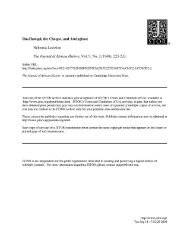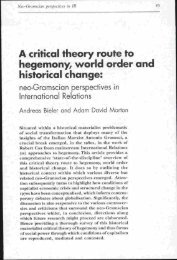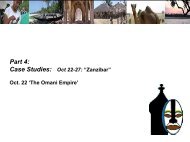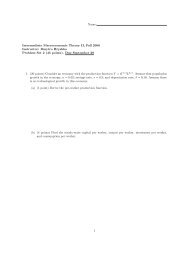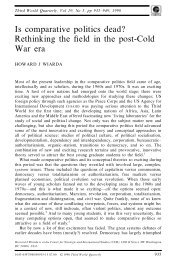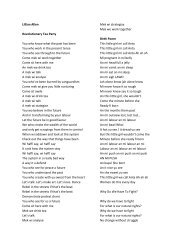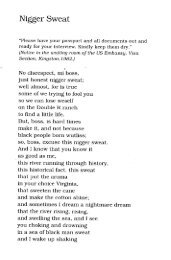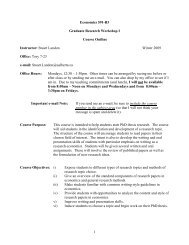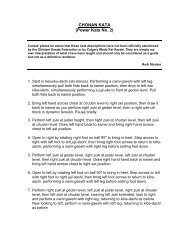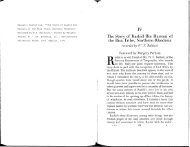personal memories revolutionary states and indian ocean migrations
personal memories revolutionary states and indian ocean migrations
personal memories revolutionary states and indian ocean migrations
You also want an ePaper? Increase the reach of your titles
YUMPU automatically turns print PDFs into web optimized ePapers that Google loves.
Lebanon” a theoretically interesting one.<br />
Akarli did this by emphasizing the<br />
stability <strong>and</strong> hybridity of the Ottoman<br />
/coastal provincial elite culture, <strong>and</strong><br />
Makdisi did it by emphasizing the<br />
Ottoman contribution to the production<br />
of Lebanese sectarianism. Zachs’s<br />
contribution completes the triptych of<br />
Ottoman/Lebanese identity dynamics<br />
by illustrating how Tanzimat reformers<br />
– the little known governor Rashid<br />
Pasha <strong>and</strong> the well known Midhat Pasha<br />
in particular – turned the vague notion<br />
of a cosmopolitan, coastal, trade<br />
oriented, bourgeois, secular, non-Shami<br />
Suriyya into an actual administrative <strong>and</strong><br />
functional unit by simultaneously<br />
enforcing reformist principles in their<br />
provincial regimes <strong>and</strong> reinforcing local<br />
resistance to homogenous, nonparticular<br />
Ottomanism. On the other<br />
h<strong>and</strong>, following the lead of her mentor<br />
Butros Abu Manneh whose subtle<br />
analyses of the local effects of elite<br />
Ottoman reformist <strong>and</strong> court politics<br />
are sometimes neglected in the study of<br />
Arab nationalism, is to be commended.<br />
More theoretically engaged in<br />
the literature of cultural interaction <strong>and</strong><br />
cognizant of the argumentative poles<br />
defining her field than the previous<br />
chapter, Zachs’s revisiting of the<br />
American missionary literature<br />
intensifies the focus on “outsiders’”<br />
contribution to shaping of the complex<br />
Syrian identity. (Again, Zachs<br />
inexplicably neglects to engage with the<br />
scholarly work of Ussama Makdisi on<br />
the topic except in an aside, while<br />
finding occasion to cite Daniel Pipes’<br />
ideologically motivated Greater Syria.)<br />
This chapter, more than the Tanzimat<br />
chapter, strays into the distant origins of<br />
the admittedly interesting Protestant<br />
imported imaginings of Syria which<br />
brought with them a new-worldly air of<br />
bold beginnings, geographical<br />
determinism <strong>and</strong> prosletyzing<br />
territoriality for the Beirut intelligentsia<br />
to strengthen their indigenous sense of<br />
Syrian identity. The argument is a<br />
convincing fleshing out of familiar<br />
http://web.mit.edu/cis/www/mitejmes/<br />
89<br />
territory, <strong>and</strong> Zachs – based on her<br />
Shihabi court historians material sides<br />
with nationalist historian Abd al-Latif al-<br />
Tibawi that the missionaries <strong>and</strong> their<br />
educational systems did not ignite, but<br />
rather encouraged, the nahda. Yet<br />
another analysis of the ubiquitous<br />
Bustani, this time in parallel with his<br />
missionary mentor Eli Smith, reveals the<br />
contours of an evolving proto-national<br />
territorial referent from balad to watan.<br />
But as with the last chapter, this one<br />
fails to make the leap from the<br />
“outsiders’” utilitarian concepts of Syria<br />
all the way to the Beiruti middle stratum<br />
intelligentsia’s (other than Butrus<br />
Bustani’s) sense of self-identity.<br />
The final chapter on genres <strong>and</strong><br />
narratives returns from imported<br />
(cartographic <strong>and</strong> territorial) concepts<br />
adapted into Syrian identity to the local<br />
elaboration of that identity in literature.<br />
It is a strong ending to a solid book in<br />
which the concept of a territorial watan<br />
descended from the hybridization of<br />
Islamic umma, minority milla, Shihabi<br />
imara, Beiruti tamaddun, Presbyterian<br />
balad, <strong>and</strong> Ottoman vilayet comes to<br />
emotional life in three new literary<br />
forms – newspapers, “new<br />
historiography” <strong>and</strong> historical novels.<br />
Zachs misses an opportunity to reach a<br />
broader audience by failing to bring her<br />
analysis directly to bear on Anderson’s<br />
concept of “imagined communities.”<br />
She limits her comments on Anderson<br />
to observing that newspapers were a<br />
tool for spreading the concept of Syria<br />
<strong>and</strong> fails to emphasize sufficiently the<br />
extent to which the very acts of<br />
producing <strong>and</strong> reading newspapers were<br />
a crucial embodiment of the complex<br />
new community identity. Attention to<br />
local historians’ works shows the watan<br />
rather than the city becoming the new<br />
unit of historiographical analysis <strong>and</strong> of<br />
intellectual abstraction as wataniyya. The<br />
highlight of the chapter is the mini-essay<br />
on the emergence of the historical<br />
novels <strong>and</strong> patriotic heroines of (yet<br />
again!) Salim al-Bustani, Butrus’ son.<br />
This topic cries out for more



